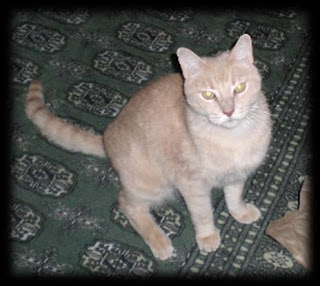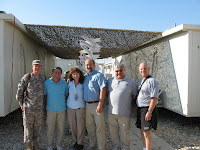Comfort of Creatures

 Here, we talk of our animals. We’ve left our pets stateside under the care of family and friends. One woman left her cats with her husband, another left her dog with her parents, a man his dog with his brother (me, my cats - Billson Brewster, left, and MoPie, below - with my sister and neighbor). We miss our animal friends as much as family members. Ou
Here, we talk of our animals. We’ve left our pets stateside under the care of family and friends. One woman left her cats with her husband, another left her dog with her parents, a man his dog with his brother (me, my cats - Billson Brewster, left, and MoPie, below - with my sister and neighbor). We miss our animal friends as much as family members. Ou r sentiments of longing for interspecies contact fosters the bond between us. My informal survey suggests having pets here would be the first thing many of us would change if we were "Ambassador for a Day".
r sentiments of longing for interspecies contact fosters the bond between us. My informal survey suggests having pets here would be the first thing many of us would change if we were "Ambassador for a Day".
Gabriel Garcia Marquez in Love in the Time of Cholera created a woman who, while collecting a menagerie of domestic and wild animals, is incapable of relating to her family members. In the biography Tatania: The biography of Izak Dinezen (1967), author Judith Thurman describes Dinezen’s mother’s as having had a frosty demeanor with her children yet cooed over her animals.
Over-involvement with animals, at the expense of, or as a substitute for, relationships with people can be pathological. For me, interacting with animals is a way to express my maternal instincts, a chance to touch, hold and bury my face in the coat of a creature warm, soft, and loving.

The Three Lives of Thomasina
DVD Cover (1964)
A young Scottish girl's cat, Thomasina, apparently
dies at the hands of her widowed veterinarian father.
The strained relationship between the girl and her
father is eventually repaired with the return of Thomasina
and the aid of a beautiful and mysterious "witch" who
seems to have powers to revive and heal animals.
So I went looking for animals.

“Atropine, a tropane alkaloid, is extracted from deadly nightshade (Atropa belladonna), jimsonweed (Datura stramonium), mandrake (Mandragora officinarum) and other plants of the family Solanaceae. It is a competitive antagonist for the muscarinic acetylcholine receptor and is classified as an anticholinergic drug.
“By blocking the action of acetylcholine at muscarinic receptors, atropine also serves as an antidote for poisoning by organophosphate insecticides and nerve gases, such as Tbun (GA), Sarin (GB), Soman (GD) and VX. Troops who are likely to be attacked with chemical weapons often carry autoinjectors with atropine and obidoxime which can be quickly injected into the thigh. . . . derives its name from Atropos, one of the three Fates who, according to Greek mythology, chose how a person was to die.”
Nearly everyone to deploy to Iraq gets training on chemical-biological weapons, how to don and properly seal a gas mask, and where to find the atropine injectors. (The kits are ubiquitous, frightening to contemplate, yet it's reassuring to know shold they be required we're prepared.)
So one of the guards named him “Atropina.”
Ten days ago I wrote his name on an old towel in black magic marker and strolled over to place it in his box as his bed. When I got to the place where he hangs around, I got scared because his little scrappy box was gone. Where was Atropina? A guard pointed out a capacious, sturdy hp computer box with a commanding presence beside the chain link fence. Someone had commandeered the cardboard box and placed it atop a wood pallet. Several layers of plasticized burlap were tucked between the cemen
 t and the pallet (insulation). Inside, original styrofoam lined the bottom with a thin layer of packing material. A flattened box lay width-wise across the top creating the effect of a Dutch roof. An arched cat door had been cut in the side of the box and written over the doorway “This box is the cat’s house.”
t and the pallet (insulation). Inside, original styrofoam lined the bottom with a thin layer of packing material. A flattened box lay width-wise across the top creating the effect of a Dutch roof. An arched cat door had been cut in the side of the box and written over the doorway “This box is the cat’s house.”
The guard called the “gato.” In moments we heard rustling, saw a paw and then a nose at the doorway, Antonio lazily and luxuriously squeezing and stretching his way through his entry.
(Watch out, Arturo, the cats are keeping up.) I placed the towel on top of the thin layer of packing material. On the outside of the box I used the black magic marker to write “ATROPINA” in three inch high letters and drew several paw prints. I wiped Atropina down with a damp towel (my wet swimsuit had been wrapped in it), releasing dirt and grime from his coat. He played with my hand through the blotchy towel.
Two days later, someone had added a pristine, white clock box (a box that clearly had come with a wall clock inside and had a clock printed on the outside) to the top of the roof making it look like a watch tower.
I added pieces of butcher paper I’d saved from belongings shipped over by State (I know my cats love that kind of newsprint paper).
Three days later, more additions. A cat’s face had been drawn into the middle of the clockface on the box. Each side of the cat door had a twelve inch high pencil drawing on cardboard: a cat in a Peruvian guard’s uniform, packing firearms. In one the cat says, “Show me your badge”, in the other he holds a dead rat on a string. Really brilliant. My fellow caretaker(s?) remains unknown to me but since I’ve not met him during my visits, it’s safe to suppose he’s on night shift.
Comments, questions, musings? Criticism, opinion, declaration? Wishes, blessings, prayers?
Have at it: leave note in "Comments".
~ Carol
Labels: animals, anthropomorphise, Atropina, biological, chemical






